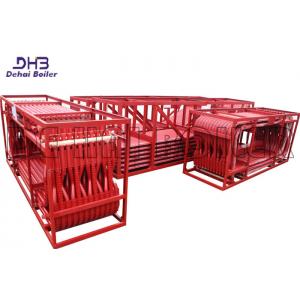
Add to Cart
Steam Generating Boiler and Industry water wall panel carbon steel raw material 3.1 certificate
Steam Boiler History
1. A boiler is a box formed by tubes that uses fire inside that box to heat water into steam. Surrounding those tubes and completely encasing the tube walls and the firebox area are the bril (brick, refractory, insulation, and lagging) materials.
2. The number and size of the tubes, the type of fuel, and the overall physical dimensions of the boiler will all vary depending on what the boiler is designed to produce (water, steam, or heat) and the industry it is intended to serve (e.g., utility, industrial, medical).
3. Many components make up or act as a support system for the boiler to meet its designed steam or heat requirements. There are the tubes that carry the water and/or steam throughout the system; soot blowers that keep the unit free of fly ash or dust by blowing steam water or air into the boiler;
4. Burners that burn the fuel (oil, gas, coal, refuse);
5. Economizers that recover heat from the exit gas and pre-heat the water used for making steam; and many more such systems, including brick, refractory, insulation, and lagging, which help the steam-generating boiler be energy and thermally efficient.
Advantages
1. The protective effect of membrane water cooling wall on the furnace wall is the most complete, so the furnace wall only needs insulation materials, rather than refractory materials, so that the thickness and weight of the furnace wall are greatly reduced, simplify the structure of the furnace wall, reduce the total weight of the boiler.
2. Membrane water wall also has good air tightness, can adapt to the requirements of positive pressure combustion on the boiler, not easy to slag formation, less air leakage, reduce the heat loss of smoke exhaust, improve the boiler thermal efficiency.
3. it can be welded into components by the manufacturer for quick and convenient installation.
4. the use of membrane wall structure of the boiler, simple maintenance, boiler service life can be greatly improved.
Note
| 1 | Control of weld penetration to satisfy mechanical and heat transfer requirements Control of the deformation to acceptable tolerances. |
| 2 | Panels routinely require straightening in the workshop after welding and heat treatment, the question to be answered is can the shop then meet the required dimensional tolerances for successful site installation? |
| 3 | Can existing shop handling procedures be used as-is without adding excessive controls that will add cost and schedule. |
| 4 | The importance of preheating and its maintenance through the welding process could cause a number of handling and shop processing issues that will substantially increase cost. |
Vertical Panel Bending

Welding Machine(SAW)
